Quick Article Highlights:
- Understand Seborrheic Dermatitis: Learn the basics of this common skin condition and its causes.
- Cream Ingredients Explained: Discover what makes a cream effective, from moisturizers to anti-inflammatories.
- Top Cream Reviews: Explore detailed reviews of anti-fungal, barrier repair, and everyday creams.
- Expert Recommendations: Find out the top-rated creams in each category based on user feedback and formula analysis.
- Make Informed Choices: Gain the knowledge to choose the best cream to manage your seborrheic dermatitis symptoms.
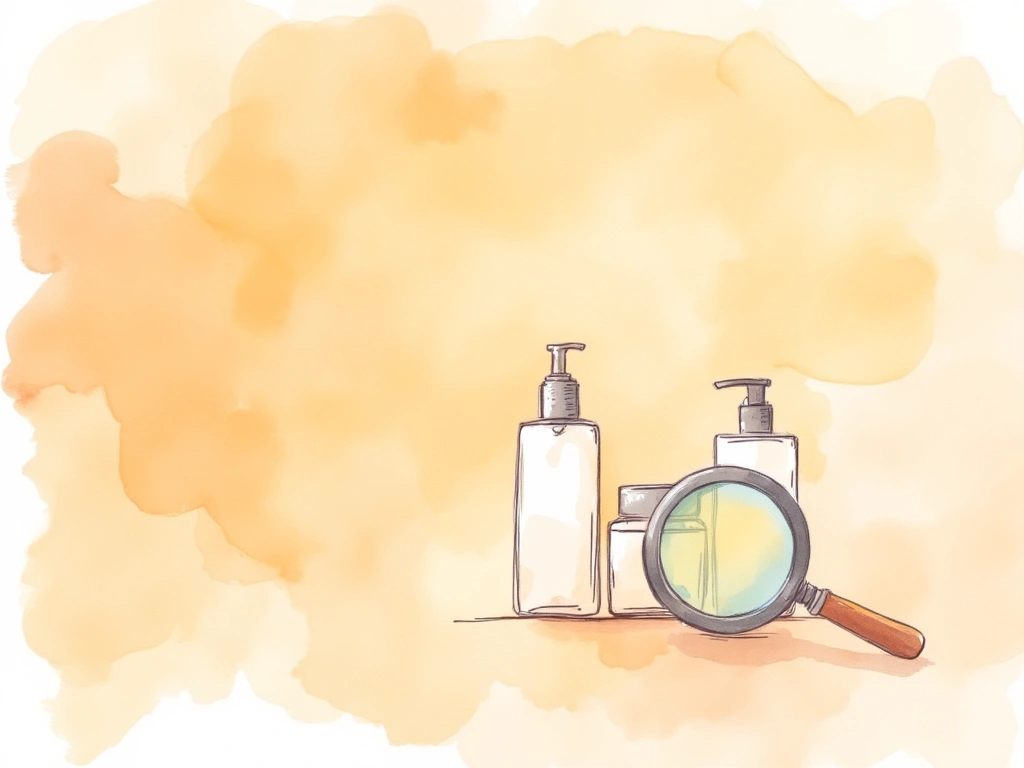
Seborrheic Dermatitis Creams: Finding Your Best Solution
Seborrheic dermatitis can be a persistent skin issue, marked by redness, itching, and flaking. Choosing the right cream is crucial for managing symptoms and improving skin health. This article provides a comprehensive overview to guide you through the numerous options and help you select the most effective seborrheic dermatitis cream for your needs.
We’ll explore:
* The fundamentals of seborrheic dermatitis and how creams can help.
* Key ingredients in effective formulations.
* Detailed reviews of leading creams across different categories.
Understanding Seborrheic Dermatitis
Before choosing a cream, it’s important to understand seborrheic dermatitis itself. This chronic skin condition requires ongoing management, and proper diagnosis is key, as it can mimic other conditions like psoriasis, rosacea, and perioral dermatitis.
Symptoms and Affected Areas
Seborrheic dermatitis presents with a range of symptoms, varying in severity from person to person [1]. Common signs include:
- Dryness
- Itchiness
- Skin flakes and scales
- Irritation
- Inflammation
The most frequently affected areas include:
- Scalp and hairline
- Ears
- Eyebrows
- Nasal folds
- Melolabial folds (smile lines)
- Chin
The scalp is often the most problematic area, while facial issues frequently begin in the nasal folds.
Causes of Seborrheic Dermatitis
While the exact cause isn’t fully understood, medical consensus points to several contributing factors [2]:
- Malassezia Yeast Overgrowth: This common skin fungus can proliferate excessively, producing irritating oleic free fatty acids.
- Altered Sebum Composition: Changes in skin oil may reduce its protective qualities against Malassezia.
- Individual Skin Sensitivity: Reactions to oleic acid vary, influencing symptom severity.
Although other theories exist, these factors are generally accepted as primary contributors by the medical community.
Treatment Approaches
Managing seborrheic dermatitis often involves controlling Malassezia yeast. Dermatologists frequently recommend treatments to suppress this fungus [3]. However, newer research suggests that improving the skin barrier might be a more effective long-term strategy [4]. Regardless of the approach, creams play a vital role in managing facial seborrheic dermatitis symptoms.
How Seborrheic Dermatitis Creams Work
To make informed choices, it’s helpful to know what’s inside these creams and how they work. Most seborrheic dermatitis creams and moisturizers are formulated with a combination of key components:
- Moisturizing Ingredients: Hydrate the skin and improve barrier function.
- Anti-inflammatory Agents: Reduce redness and irritation.
- Antioxidants: Protect skin cells and cream ingredients.
- Preservatives: Prevent microbial growth and ensure product safety.
Moisturizing Ingredients: Hydration is Key
Moisturizers are fundamental to creams, using a blend of ingredients for optimal hydration:
- Occlusives: Create a barrier to prevent water loss (TEWL) – examples include petrolatum, mineral oils, and silicones.
- Humectants: Attract moisture to the skin – such as glycerin, propylene glycol, sodium PCA, and urea.
- Emollients: Soften and smooth skin, filling in cracks; some also act as occlusives or humectants – examples are cetyl alcohol and ceramides.
These components form the base of most creams, providing essential hydration.
Anti-inflammatory Agents: Soothing Irritation
While corticosteroids are common for inflammation, creams often include gentler alternatives [5]. Natural anti-inflammatory agents are favored for long-term use due to fewer side effects. Common examples include:
- Aloe vera
- Bisabolol
- Shea butter
- Licorice extracts
- Niacinamide (vitamin B3)
These ingredients help calm inflammation, a major symptom of seborrheic dermatitis.
Antioxidants: Skin and Formula Protection
Antioxidants serve dual purposes in creams:
- Skin Benefit: Reduce free radicals on the skin surface, promoting healthier skin.
- Formula Protection: Prevent oxidation of other ingredients, maintaining cream effectiveness.
For best results, use creams with antioxidants closer to their production date. Popular antioxidants in creams include:
- Vitamin C
- Vitamin E
- Grape seed extract
Preservatives: Ensuring Safety and Shelf Life
Water-based creams require preservatives to prevent microbial contamination. However, some preservatives can irritate sensitive skin [6]. A balanced preservative system is crucial to protect the product without disrupting the skin microbiome [7]. The preservative system can significantly impact skin reaction, especially for sensitive individuals.
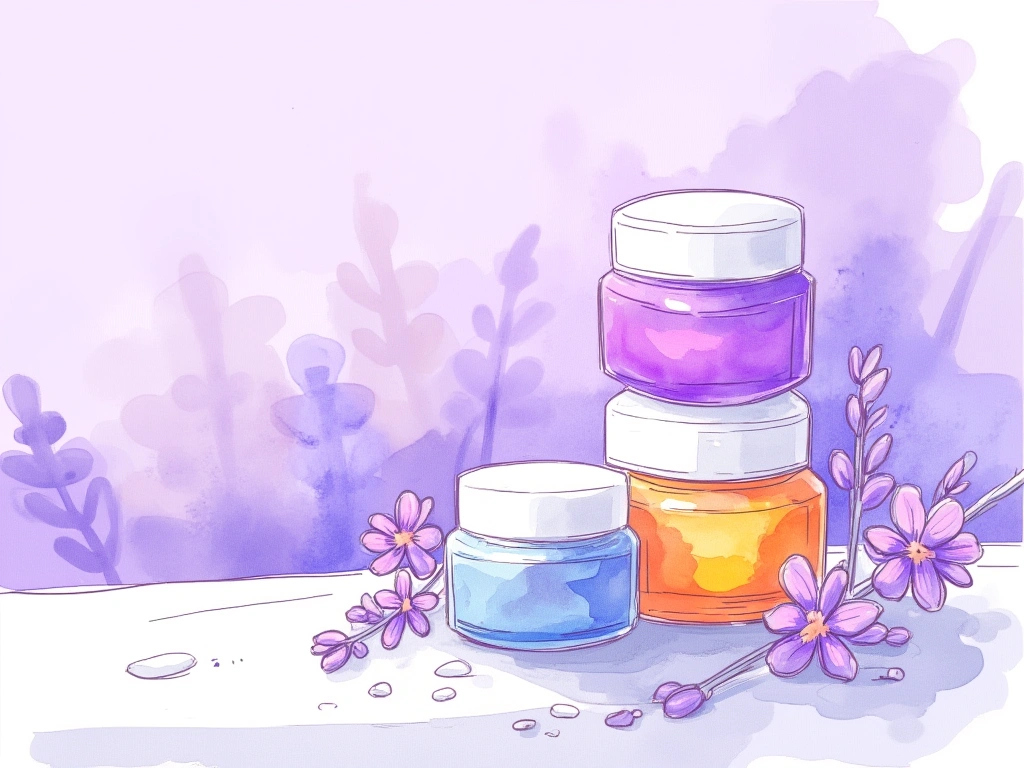
Top Seborrheic Dermatitis Creams Reviewed
Choosing the right cream can feel overwhelming. This review is based on community recommendations, popularity among seborrheic dermatitis sufferers, and expert analysis, categorizing creams for targeted treatment.
Cream Categories:
- Anti-fungal/Medicated Creams: Directly target Malassezia yeast.
- Barrier Repair Creams: Focus on restoring the skin’s natural defenses.
- Common Moisturizing Creams: Offer general hydration and barrier support.
Corticosteroid creams are not included
While effective for short-term relief, long-term use of corticosteroid creams can lead to significant side effects, making them less suitable for chronic conditions like seborrheic dermatitis [8, 9]. This review focuses on creams for sustained management without these risks.
Evaluation Criteria: How We Rated Each Cream
To provide a fair and unbiased review, we evaluated creams based on these criteria:
- User Feedback: Aggregated reviews from online marketplaces and communities.
- Formula – Functional Ingredients: Effectiveness and relevance of key ingredients.
- Formula – Preservative System: Gentleness and potential for irritation.
- Formula – Irritation Potential: Overall likelihood of causing skin irritation.
- Formula – Absorption Rate: How well the cream absorbs into the skin.
- Formula – Natural Ingredient Proportion: Preference for natural ingredients.
- Cost – Real-World Usage: Affordability based on usage frequency and amount needed.
- Availability: Ease of purchasing the product.
Anti-fungal/Medicated Creams: Targeting the Cause
Anti-fungal creams are a primary treatment approach, aiming to reduce Malassezia yeast activity, a key factor in seborrheic dermatitis. These creams typically contain active ingredients that combat fungal growth. The following options are available over-the-counter.
Noble Formula Zinc Pyrithione Cream
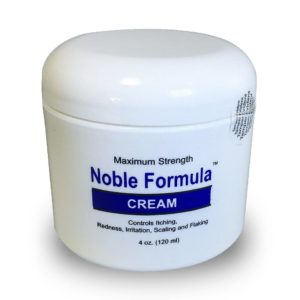
Pyrithione Zinc (.25%),Purified Water, Almond Oil, Squalane, Cyclomethicone, Rose Hip Oil, Arachidyl Behenyl Alcohol, & Archidyl Glucoside (a naturally derived emollient), Natural Vitamin E (d-Alpha-Tocopherol), Cetearyl Alcohol, Cetearyl Alcohol Glucoside, Sodium Laurel Sulfate, Sodium Hydroxymethylglycinate (an amino acid derivative), and TEA-Carbomer
Review: Noble Formula utilizes zinc pyrithione, a proven anti-fungal agent. While it receives positive user feedback, some users report diminishing effectiveness over time. The formula includes sodium lauryl sulfate, a known irritant, and a preservative (Sodium Hydroxymethylglycinate) with a moderate safety rating. The jar packaging may also necessitate a stronger preservative.
Concerns: Sodium lauryl sulfate and preservative choice may cause irritation for sensitive skin.
DermaZinc Zinc Pyrithione Cream
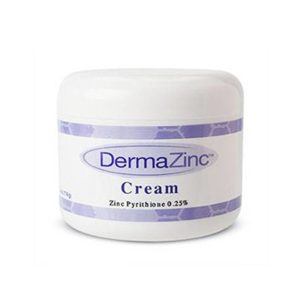
Active Ingredients: Zinc Pyrithione 0.25%. Inactive Ingredients: Purified Water (Aqua), Stearic Acid, Glycol Stearate, Isopropyl Palmitate, Mineral Oil, Aloe Vera, Triethanolamine, Cetyl Alcohol, Carbomer, DMDM Hydantoin, PEG-75 Lanolin, Methylparaben, Tocopherol Acetate, Dimethicone, Undecylenic Acid, Sodium Lauryl Sulfate
Review: DermaZinc is another zinc pyrithione cream, similar to Noble Formula. It replaces vegetable oils with mineral oil and stearic acid and uses a paraben-based preservative system, which can be aggressive.
Comparison: Noble Formula is slightly favored due to its milder formulation, though both could benefit from gentler preservatives.
MG217 Psoriasis Treatment 2% Coal Tar Ointment
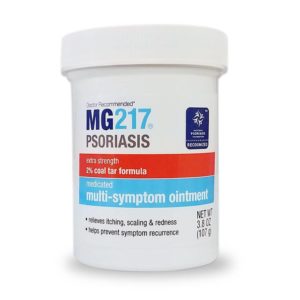
Coal Tar 2% (from Coal Tar Topical Solution, USP 20%), petrolatum, cetyl alcohol, polysorbate 80, microcrystalline wax
Review: MG217 Coal Tar Ointment, primarily for psoriasis, is also effective for seborrheic dermatitis. It uses coal tar, a time-tested active ingredient [10, 11]. User reviews are positive, noting its effectiveness in reducing redness and psoriasis symptoms. The formula is simple, water-free (no preservatives needed), and petrolatum-based, making it very moisturizing.
Drawbacks: Coal tar has a noticeable odor and can darken skin tone.
Overall: A potent option if you can tolerate the smell and color.
Alternative Coal Tar Creams
- Dermarest Psoriasis Medicated Moisturizer
Ingredients: Water, Caprylic/Capric Triglyceride, Mineral Oil, Sodium Citrate, Cetyl Alcohol, Butylene Glycol, Stearic Acid, Polysorbate 60, Glyceryl Stearate, Carbopol Ultrez, Zinc PCA, Panthenol, Camellia Sinensis Leaf Extract, Algae Extract, Artemisia Vulgaris Extract, Dipotassium Glycyrrhizate, Rheum Palmatum Extract, Carthamus Tinctorius (Safflower) Flower Extract, Rosa Damascena Extract, Triethanolamine, Disodium Edta, Methylparaben, Propylparaben, Dimethicone, Dmdm Hydantoin, Kukui Nut Oil - Creme Classique Coal Tar Cream
Ingredients: Aqua (Water), Ceteareth-20, Cetearyl Alcohol, Coal Tar (6%), Imidiazolidinyl Urea, Methylparaben, Paraffinium Liquidum (Mineral Oil), Petrolatum, Propylparaben, Triclosan 2%
Sebclair Dermatola Cream (Promiseb Topical Cream)
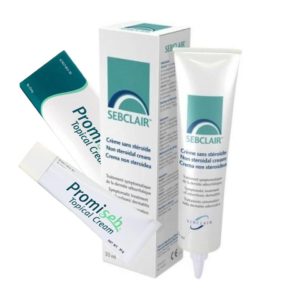
Aqua, Isohexadecane, Butyrospermum parkii (Shea butter), Pentylene glycol, Ethylhexyl palmitate, Ceraalba, PEG-30 dipolyhydroxystearate, Bisabolol, Polyglyceryl-6 polyrycynoleate, Tocopheryl acetate, Hydrogenated castor oil, Lactic acid, Solanum lycopersicum (tomato?), Citrus limonum, Vaccinum myrtilus, Citric acid, Malic acid, Allantoin glycyrrhentinic acid, Butylene glicol, Magnesium sulphate, Piroctone olamine 1%, Magnesium stearate, Disodium EDTA, Vitis vinifera, Ascorbyl tetraisopalmitate, Propyl gallate, Telmesteine.
Review: Sebclair Dermatola Cream (Europe) and Promiseb Topical Cream (North America) are the same formulation, differing due to FDA approval status of the active ingredient, piroctone olamine. It’s a non-steroidal cream effective for seborrheic dermatitis [12]. Piroctone olamine is an anti-fungal similar to ketoconazole [13]. The cream also focuses on moisturizing and barrier repair with shea butter and pentylene glycol. Anti-inflammatories like bisabolol and vitamin E are included.
Pros: Natural ingredients, dual action (anti-fungal and barrier repair).
Cons: Availability in North America requires a prescription for “off-label” use. Preservative system is not clearly identified.
Alternative Piroctone Olamine Creams
- Eucerin Skin Calming Natural Oatmeal Enriched Creme (Red Cap Formula – See Notes Later in Article)
Ingredients: Water, Glycerin, Cetyl Palmitate, Mineral Oil, Caprylic/Capric Triglyceride, Octyldodecanol, Cetyl Alcohol, Glyceryl Stearate, Colloidal Oatmeal, Dimethicone, Methylpropanediol, PEG-40 Stearate, 1,2-Hexanediol, Phenoxyethanol, Piroctone Olamine, Carbomer, Benzyl Alcohol, Polyglyceryl-2 Caprate, Decylene Glycol - La Roche Posay Kerium DS (Not Sold in North America)
Ingredients: Aqua / Water Isononyl Isononanoate Glycerin Dimethicone Ammonium Polyacryldimethyltauramide / Ammonium Polyacryloyldimethyl Taurate Myristyl Myristate Stearic Acid Potassium Cetyl Phosphate Zinc PCA Glyceryl Stearate Se Sodium Hydroxide Palmitic Acid Disodium Edta Capryloyl Glycine Vitreoscilla Ferment Citric Acid Xanthan Gum Acrylates Copolymer Sodium Benzoate Phenoxyethanol Piroctone Olamine Parfum / Fragrance
Family Care Clotrimazole Anti-Fungal Cream
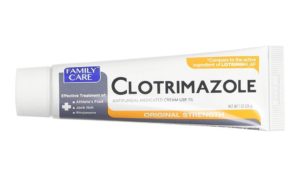
Active Ingredients: Clotrimazole 1%. Inactive Ingredients: 2-octyldodecanol, benzyl alcohol, cetaryl alcohol, cetyl esters, monobasic sodium phosphate dihydrate, polysorbate 60, propylene glycol, purified water, sorbitan stearate
Review: Family Care Clotrimazole Cream uses clotrimazole, a common anti-fungal agent , though considered less potent than ketoconazole. The formula contains potential irritants like benzyl alcohol and polysorbate 60 [14, 15].
Considerations: May be effective with careful use and spot testing due to potential irritants.
Curad Silver Solution Antimicrobial Gel
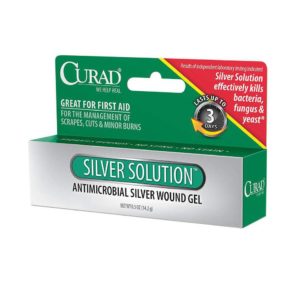
Active Ingredients: Silver Chloride (55ppm). Inactive Ingredients: Carbomer, Glycerin, Sodium Chloride, Triethanolamine, Water
Review: Curad Silver Solution Gel features silver chloride, an antimicrobial agent with anti-fungal properties [16, 17, 18]. Its minimal ingredient list is a major plus. It’s preservative-free due to silver chloride’s antimicrobial action and low water content. Glycerin is used as a humectant, a better choice than propylene glycol.
Pros: Minimalist formula, preservative-free, effective anti-fungal action reported.
The Ordinary Azelaic Acid Suspension
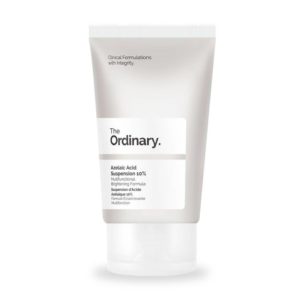
Aqua (Water), Isodecyl Neopentanoate, Dimethicone, Azelaic Acid, Dimethicone/Bis-Isobutyl PPG-20 Crosspolymer, Dimethyl Isosorbide, Hydroxyethyl Acrylate/Sodium Acryloyldimethyl Taurate Copolymer, Polysilicone-11, Isohexadecane, Tocopherol, Trisodium Ethylenediamine Disuccinate, Isoceteth-20, Polysorbate 60, Triethanolamine, Ethoxydiglycol, Phenoxyethanol, Chlorphenesin.
Review: The Ordinary Azelaic Acid Suspension uses azelaic acid, effective for acne and rosacea [19, 20], and showing promise for seborrheic dermatitis [21]. Azelaic acid is also produced by Malassezia yeast itself. User feedback and anecdotal reports, like [this Reddit comment][2], suggest its benefits. The formula is complex with silicones and synthetic ingredients.
Considerations: Complex formula, silicone-based, but azelaic acid offers potential benefits.
Barrier Repair Creams: Strengthening Skin’s Defenses
Barrier repair creams focus on restoring the skin’s natural barrier function. Research indicates that barrier defects are significant in seborrheic dermatitis []. Glycerin is a key ingredient in this approach [].
Cetaphil Pro Eczema Soothing Moisturizer
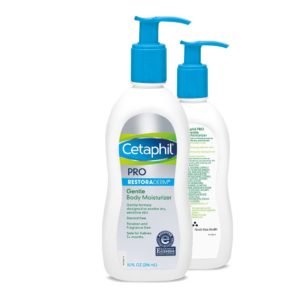
Water, Glycerin, Caprylic/Capric Triglyceride, Helianthus Annus (Sunflower) Seed Oil, Pentylene Glycol, Butyrospermum Parkii (Shea Butter), Sorbitol, Cyclopentasiloxane, Cetearyl Alcohol, Behenyl Alcohol, Glyceryl Stearate, Tocopheryl Acetate, Hydroxypalmitoyl Sphinganine, Niacinamide, Allantoin, Panthenol, Arginine, Disodium Ethylene Dicocamide PEG-15 Disulfate, Glyceryl Stearate Citrate, Sodium PCA, Ceteareth-20, Sodium Polyacrylate, Caprylyl Glycol, Citric Acid, Dimethiconol, Disodium EDTA, Sodium Hyaluronate, Cetyl Alcohol.
Review: Cetaphil Pro Eczema Moisturizer is designed for sensitive skin and focuses on barrier repair rather than active anti-fungal ingredients. It uses a combination of humectants (glycerin, pentylene glycol, sodium hyaluronate) and occlusives (caprylic/capric triglycerides, shea butter). Preservatives are likely caprylyl glycol and reduced water activity, a gentle approach. Personal experience and community feedback My Seborrheic Dermatitis Skin Regimen highlight its effectiveness for seborrheic dermatitis.
Pros: Excellent formula for barrier repair, gentle preservatives, widely available.
Alternative Barrier Repair Creams
- CeraVe Moisturizing Cream
Ingredients: Purified Water, Glycerin, Ceteareth-20 And Cetearyl Alcohol, Caprylic/Capric Triglyceride, Behentrimonium Methosulfate And Cetearyl Alcohol, Cetyl Alcohol, Ceramide 3, Ceramide 6-II, Ceramide 1, Hyaluronic Acid, Cholesterol, Petrolatum, Dimethicone, Potassium Phosphate, Dipotassium Phosphate, Sodium Lauryl Lactylate, Disodium Edta, Phenoxyethanol, Methylparaben, Propylparaben, Phytosphingosine, Carbomer, Xanthan Gum - First Aid Beauty Ultra Repair Cream Intense Repair
Ingredient: Water, Stearic Acid, Glycerin, C12-15 Alkyl Benzoate, Caprylic/Capric Triglyceride, Glyceryl Stearate Se, Glyceryl Stearate, Cetearyl Alcohol, Butyrospermum Parkii Butter, Dimethicone, Squalane, Allantoin, Camellia Sinensis Leaf Extract, Caprylyl Glycol, Ceramide 3, Chrysanthemum Parthenium Extract, Colloidal Oatmeal, Disodium EDTA, Eucalyptus Globulus Leaf Oil, Glycyrrhiza Glabra Root Extract, Sodium Hydroxide, Xanthan Gum, Phenoxyethanol.
Gold Bond Ultimate Healing Skin Therapy Lotion
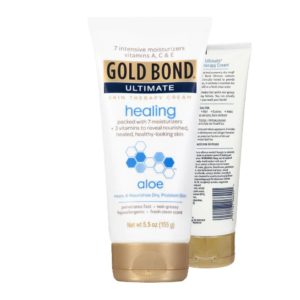
Water, Glycerin, Dimethicone, Petrolatum, Jojoba Esters, Cetyl Alcohol, Aloe Barbadensis Leaf Juice, Stearyl Alcohol, Distearyldimonium Chloride, Cetearyl Alcohol, Steareth-2, Steareth-21, Propylene Glycol, Chamomilla Recutita (matricaria) Flower Extract, Polysorbate 60, Stearamidopropyl Pg-dimonium Chloride Phosphate, Methyl Gluceth-20, Tocopheryl Acetate, Magnesium Ascorbyl Phosphate, Hydrolyzed Collagen, Hydrolyzed Elastin, Retinyl Palmitate, Hydrolyzed Jojoba Esters, Glyceryl Stearate, Edta, Fragrance, Potassium Hydroxide, Diazolidinyl Urea, Methylparaben
Review: Gold Bond Ultimate Healing Lotion, while not specifically a barrier repair cream, is included due to its moisturizing properties and reported effectiveness for seborrheic dermatitis [YouTube video by RDKamikaze][3]. It contains glycerin, aloe vera, collagen, and elastin. Occlusives are dimethicone and petrolatum.
Cons: Preservatives (Diazolidinyl Urea, Methylparaben) and fragrance may be irritating.
SebaMed Extreme Dry Skin Relief Face Cream 5% Urea

Water (Aqua), Caprylic/Capric Triglyceride, Urea, Glycerin, Tocopheryl Acetate, Glyceryl Stearate, Panthenol, Cetearyl Alcohol, Asiaticoside, Asiatic Acid, Madecassic Acid, Bisabolol, Sodium Carbomer, Parfum, Benzyl Alcohol, Phenoxyethanol, Sodium Benzoate
Review: SebaMed Urea Cream focuses on intense moisturization with urea and glycerin. Urea is beneficial for dry skin and can reduce hyperproliferation seen in seborrheic dermatitis []. It includes collagen-boosting ingredients and bisabolol for anti-inflammation.
Cons: Preservatives (benzyl alcohol, phenoxyethanol, sodium benzoate) and fragrance may cause irritation.
Alternative Urea Creams
- Eucerin Smoothing Face Cream 5% Urea
Aqua, Urea, Glycerin, Caprylic/Capric Triglyceride, Cyclomethicone, Dimethicone, Pentaerythrityl Tetraisostearate, Triisostearin, Cetyl Alcohol, Sodium Lactate, Glyceryl Stearate, Benzyl Alcohol, PEG-40 Stearate, Biosaccharide Gum-1, Methylparaben, Lactic Acid, Lanolin Alcohol, Phenoxyethanol - Udderly Smooth Extra Care Cream 10% Urea
Active Ingredient: Urea 10% (Keratolytic). Inactive ingredients: Aqua, Stearic Acid, Peg-2 Stearate, Propylene Glycol, Isopropyl Myristate, Dimethicone, Lanolin Oil, Paraffinum Liquidum, Triethanolamine, Allantoin, Methylparaben, Propylparaben
EpiCeram Skin Barrier Emulsion
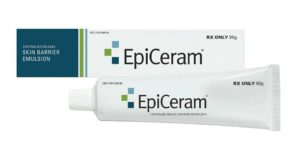
Purified Water, MultiSal™ Neolipids¹, Glyceryl Stearate, Squalane, Glycerin, PEG-100 Stearate, Hydroxypropyl Bispalmitamide MEA (Ceramide), Petrolatum, Dimethicone, Phenoxyethanol, Cholesterol, Conjugated Linoleic Acid, Citric Acid, Palmitic Acid, Xanthan Gum, Potassium Hydroxide, Disodium EDTA, Sorbic Acid, Capric Acid. ¹Proprietary microencapsulation system for gradual delivery of key ingredients including Ceramide, CLA, Cholesterol and Palmitic Acid (Formulated with E.Cerifera (Candelilla) wax, corn syrup solids, and modified food starch).
Review: EpiCeram is a prescription cream for atopic dermatitis, focusing on barrier repair. It contains ceramides, cholesterol, and fatty acids delivered via a microencapsulation system. While not specifically studied for seborrheic dermatitis, its barrier-enhancing properties are relevant.
Cons: Prescription needed, costly, and availability may be limited.
Alternative Prescription Barrier Repair Creams
- 3M Cavilon Durable Barrier
Active Ingredients: Dimethicone 1.3% (Skin Protectant). Inactivate Ingredients: Water (Aqua), Diisooctyl Adipate, Cocos Nucifera (Coconut) Oil, PPG-15 Stearyl Ether, Dipropylene Glycol, Isopropyl Palmitrate, Mineral Oil (Paraffinum Liquidum), Ethylene/Acrylic Acid Copolymer, Acrylate Terpolymer, Paraffin, Magnesium Sulfate, Propylene Glycol, Fragance, Diazolidinyl Urea, Methylparaben, Propylparaben - Kendall Moisture Barrier
Active Ingredient: Dimethicone 5%. Inactive ingredients: Water, Simmondsia Chinensis (jojoba) Seed Oil, Zea Mays (corn) Starch, Cetearyl Alcohol, Glyceryl Stearate, Cirtus Aurantium Bergamia (bergamot) Fruit Oil, Citrus Medica Vulgaris Peel Oil, Sodium Stearoyl Lactylate, Retinyl Palmitate, Tocopheryl Acetate, Isopropyl Palmitate, Propylene Glycol, Triethanolamine, Sodium Pca, Carbopol, Butyrospermum Parkii (shea Butter), Phenoxyethanol, Methylparaben, Butylparaben, Propylparaben, Isobutylparaben, Ethylparaben
Common Creams: Accessible and Affordable Options
These widely available creams can provide effective moisturization and barrier support for seborrheic dermatitis management, often at a lower cost.
Eau Thermale Avène Skin Recovery Cream
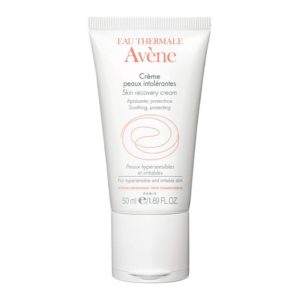
Avène Thermal Spring Water, Mineral Oil, Glycerin, Glyceryl Stearate, Squalane, Cyclopentasiloxane, Clycohexasiloxane, Serine, Carbomer, Tetrasodium Edta, Triethanolamine
Review: Avène Skin Recovery Cream is a minimalist, preservative-free formula. It utilizes Avène thermal spring water, mineral oil, glycerin, and squalane. Thermal water may help regulate skin pH and reduce microbial activity [22]. Squalane and serine offer skin-healing benefits [23]. Preservative-free due to sterile manufacturing and packaging.
Pros: Minimalist, preservative-free, soothing thermal water.
Simple Kind to Skin Facial Moisturizer
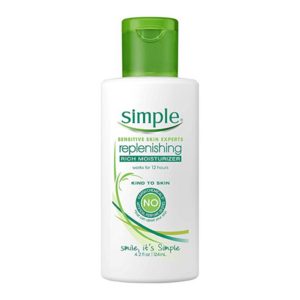
Water (Aqua, Eau), Caprylic/Capric Triglyceride, Glycerin, Polyglyceryl-3 Methyl Glucose Distearate, Stearyl Alcohol, Panthenol, Polyacrylamide, Stearic Acid, C13-14 Isoparaffin, Caprylyl Glycol, Laureth-7, Allantoin, Pentylene Glycol, Bisabolol, Disodium Edta, Lactic Acid, Sodium Lactate, Serine, Sodium Hydroxide, Urea, Sorbitol, Sodium Chloride, Citric Acid, Methylisothiazolinone, Phenoxyethanol.
Review: Simple Kind to Skin Moisturizer is a basic, affordable option with skin-friendly ingredients like glycerin, allantoin, panthenol, and urea. Occlusives include caprylic/capric triglycerides and stearic acid.
Cons: Contains methylisothiazolinone, a known irritant [24].
Eucerin Skin Calming Natural Oatmeal Enriched Creme (Blue Cap Formula)
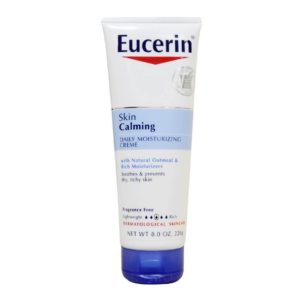
Blue Cap VersionWater, Glycerin, Cetyl Palmitate, Mineral Oil, Caprylic/Capric Triglyceride, Octyldodecanol, Cetyl Alcohol, Glyceryl Stearate, Colloidal Oatmeal, Dimethicone, PEG-40 Stearate, Carbomer, Sodium Hydroxide, Phenoxyethanol, Benzyl Alcohol, DMDM Hydantoin, Methylparaben, Ethylparaben
Review: Eucerin Skin Calming Creme (Blue Cap) is a popular, highly hydrating cream with colloidal oatmeal. Colloidal oatmeal offers moisturizing, anti-inflammatory, and soothing benefits [25]. It’s well-regarded for eczema but also used for seborrheic dermatitis. Occlusives include mineral oil and caprylic/capric triglycerides.
Cons: Paraben preservatives are a concern for some.
Note: Eucerin’s red cap version has a different formula with piroctone olamine and a paraben-free preservative system, but some users find it less effective than the original blue cap formula.
Alternative Colloidal Oatmeal Creams
- Aveeno Baby Eczema Therapy Moisturizing Cream
Active Ingredients: Colloidal Oatmeal 1 % (Skin Protectant). Inactivate Ingredients: Water, Glycerin, Panthenol, Distearyldimonium Chloride, Petrolatum, Isopropyl Palmitate, Cetyl Alcohol, Dimethicone, Avena Sativa Kernel Oil, Benzalkonium Chloride, Ceramide NP, Sodium Chloride, Steareth-20 (Oat), Avena Sativa Kernel Extract (Oat) - La Roche-Posay Lipikar Eczema Cream Soothing Relief Cream
Active Ingredient: Colloidal Oatmeal 1% (Skin Protectant). Inactive ingredients: Water, Shea Butter, Glycerin, Dimethicone, Mineral Oil, Niacinamide, Cetearyl Alcohol, Rapeseed Seed Oil, Ammonium Polyacryloyldimethyl Taurate, PEG-100 Stearate, Glyceryl Stearate, Tocopherol, Sodium Benzoate, PEG-20 Methyl Glucose Sesquistearate, Dimethiconol, Mannose, Xanthan Gum, Pentaerythrityl Tetra-Di-T-Butyl Hydroxyhydrocinnamate, Capryloyl Glycine, Microcrystalline Wax, Sorbitan Tristearate, Paraffin, Disodium EDTA, Vitreoscilla Ferment, Citric Acid
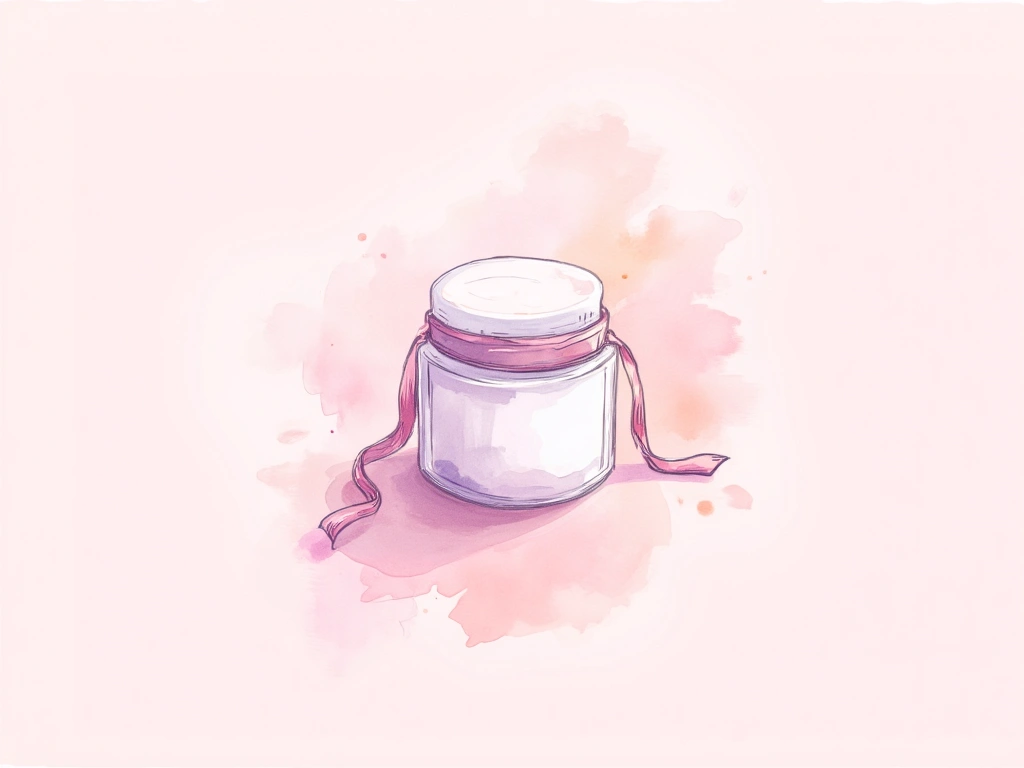
Top Seborrheic Dermatitis Creams: Category Winners
After reviewing these creams, here’s a summary of the top performers in each category, considering user feedback, formula quality, cost, and availability.
Key Considerations When Choosing:
- User Feedback is a Guide: Ratings reflect general product reviews, not solely for seborrheic dermatitis.
- Targeted Solutions May Be More Effective: Medicated creams are often more directly effective than barrier repair or general moisturizers.
- Samples and Patch Testing: Always test creams on a small area first due to individual sensitivities.
Top Anti-fungal/Medicated Creams
| Cream | Feedback | Formula | Cost | Availability | Overall¹ | Overall² |
|---|---|---|---|---|---|---|
| Noble Formula Zinc Pyrithione Cream | 4 | 3.5 | 4 | 3.5 | 11.5 | 15 |
| DermaZinc Zinc Pyrithione Cream | 4 | 3 | 4 | 3.5 | 11 | 14.5 |
| MG217 Psoriasis Treatment 2% Coal Tar Ointment | 4.5 | 4 | 4.5 | 3.5 | 13 | 16.5 |
| Sebclair Dermatola Cream (Promiseb Topical Cream) | 4.5 | 4.5 | 4 | 2 | 13 | 15 |
| Family Care Clotrimazole Anti-Fungal Cream | 4.5 | 3 | 4.5 | 3.5 | 12 | 15.5 |
| Curad Silver Solution Antimicrobial Gel | 5 | 4.5 | 3.5 | 4 | 13 | 17 |
| The Ordinary Azelaic Acid Suspension | 4 | 3.5 | 3.5 | 3.5 | 11 | 14.5 |
¹ Overall score excluding availability. ² Overall score including availability.
Top Picks (Medicated Creams):
- Curad Silver Solution Antimicrobial Gel: Winner due to high feedback, minimal formula, and good availability.
- MG217 Psoriasis Treatment 2% Coal Tar Ointment: Strong contender if odor and skin darkening are acceptable.
- Family Care Clotrimazole Anti-Fungal Cream: Budget-friendly and effective, but consider potential irritants.
Sebclair (Promiseb) is also highly rated but prescription requirement impacts availability.
Top Barrier Repair Creams
| Cream | Feedback | Formula | Cost | Availability | Overall¹ | Overall² |
|---|---|---|---|---|---|---|
| Cetaphil Pro Eczema Soothing Moisturizer | 4.5 | 5 | 4 | 5 | 13.5 | 18.5 |
| Gold Bond Ultimate Healing Skin Therapy Lotion | 4.5 | 3.5 | 4.5 | 5 | 12.5 | 17.5 |
| Sebamed Extreme Dry Skin Relief Face Cream 5% Urea | 3.5 | 4 | 3.5 | 4.5 | 11 | 15.5 |
| EpiCeram Skin Barrier Emulsion | 4 | 4.5 | 3.5 | 2 | 12 | 14 |
¹ Overall score excluding availability. ² Overall score including availability.
Top Pick (Barrier Repair Cream):
- Cetaphil Pro Eczema Soothing Moisturizer: Clear winner with excellent formula, user feedback, availability, and price.
Gold Bond is a strong runner-up, and prescription barrier creams like EpiCeram are options for more intensive treatment if cost and access are not barriers.
Top Common Creams
| Cream | Feedback | Formula | Cost | Availability | Overall¹ | Overall² |
|---|---|---|---|---|---|---|
| Eau Thermale Avène Skin Recovery Cream | 5 | 4.5 | 3.5 | 4 | 13 | 17 |
| Simple Kind to Skin Facial Moisturizer | 4 | 3.5 | 4.5 | 5 | 12 | 17 |
| Eucerin Skin Calming (Blue Cap Formula) | 5 | 3.5 | 5 | 4.5 | 13.5 | 18 |
¹ Overall score excluding availability. ² Overall score including availability.
Top Picks (Common Creams):
- Eucerin Skin Calming (Blue Cap Formula): Leads due to user feedback and affordability, despite preservative concerns.
- Eau Thermale Avène Skin Recovery Cream: Best choice if preservative-free and minimalist formulas are prioritized, and cost is less of a concern.

In Conclusion: Your Path to Soothed Skin
Finding the ideal seborrheic dermatitis cream involves understanding your skin, exploring different types of creams, and perhaps some experimentation. This guide provides a starting point, with detailed reviews and categorized recommendations.
Key Takeaways:
- Seborrheic dermatitis is linked to Malassezia yeast and skin barrier dysfunction.
- Creams work by moisturizing, reducing inflammation, and/or targeting yeast.
- Medicated, barrier repair, and common creams each offer unique benefits.
- Curad Silver Solution, Cetaphil Pro Eczema, and Eucerin Skin Calming (Blue Cap) are top-rated in their categories.
Ultimately, the best cream is one that effectively manages your symptoms and suits your individual skin needs. We encourage you to use this information to make informed decisions and find lasting relief.
If you have further questions, suggestions, or personal experiences with seborrheic dermatitis creams, please share in the comments below. We are committed to keeping this resource updated and helpful.
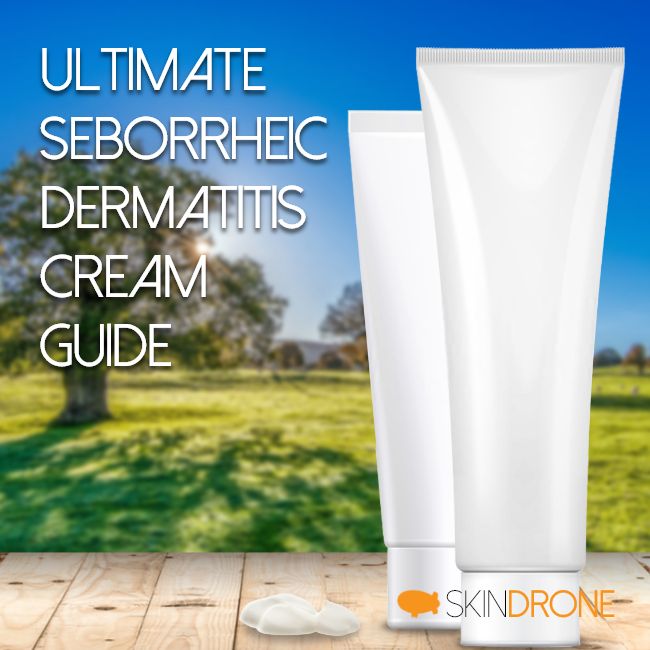

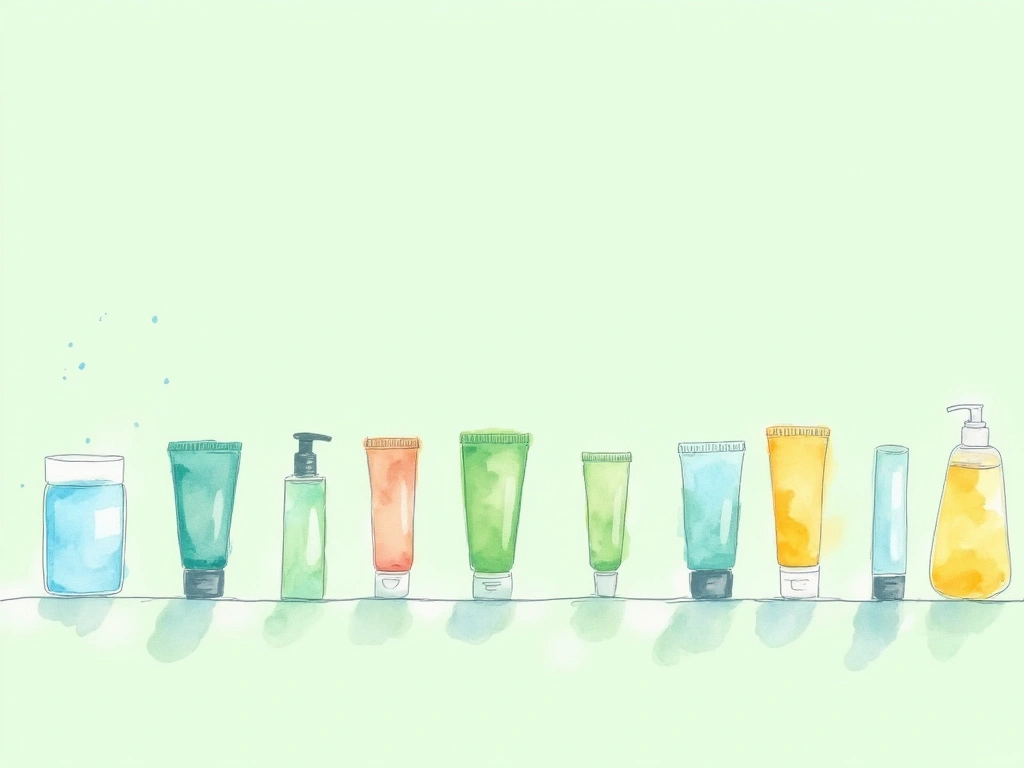
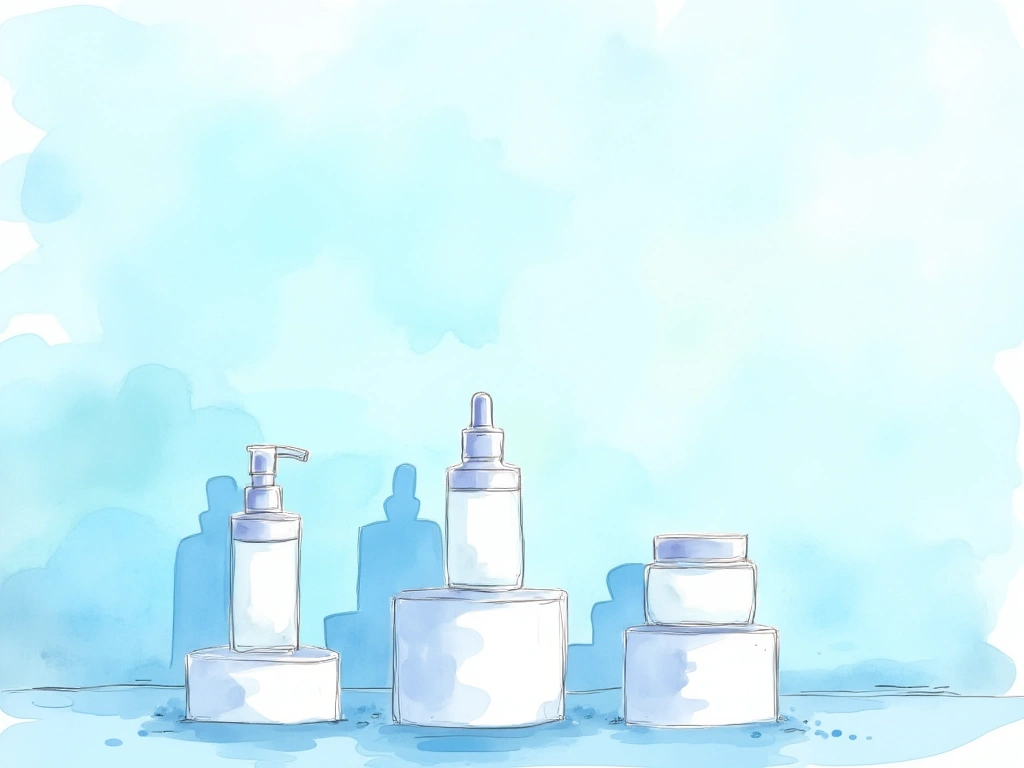

Hi again! I have found an acne cream that helps with stubborn breakouts of SDand my Rosacea! Yes, it will turn the skin pink but it does not burn like much of the acne products! It is called Alba Botanical, Asne dote Oil Control Lotion. I also like Cerave PM lotion for faces and Cerave Moisture Cream for softening scalp scales etc. No luck with the Gold Bond Ultimate Psoriasis (pricey too) but TriDerma Psoriasis is a wee better than Gold Bond. My RX for Ketaconzole Foam failed big time and so did a sample of Soolantra from my Dermatologist. I am willing to try ANYTHING and am now using ACV inside and out along with Olive Oil, Coconut Oil and Seabuck Thorn Oil individually and spaced a week apart. Thanks for your insight and work!! Lee
Reply PermalinkWhich of the creams or barriers can be used on eyelids wit sebhorrea dermatitis. otherwise what can be used on a chronic type on eyelids?
Reply PermalinkReally helpful, just trying to digest it all, such a big subject. The way you have compiled the info is excellent, thankyou!
Reply PermalinkDear Christine,
Thank you for the kind comment!
Glad to hear the article proved a relavent read.
Really wish there were more answers out there for us.
All the best!
Reply PermalinkDear Phyllis,
Thanks for taking the time to write.
From my experience, application in and around the eye is really quite tricky.
Not sure if you’ve come across it yet, but an earlier post dedicated specifically to treating seborrheic dermatitis on the eyelids was discussed in a previous post:
On the first attempt, going with something more mild like the baking soda compresses or saline rinses may be worth a try. However, in regards to anti-fungal or medicated solutions, it’s probably best to consult with a local pharmacist or doctor. Perhaps prescribe/formulate a dedicated formula specifically for use in this sensitive area.
In any case, if you still have questions beyond the post linked above, let me know.
Wish you all the best and hope you see some progress!
Reply PermalinkThanks, Michael.
Reply PermalinkYour detailed research is helping many!!
Wow, I really did not expect such a in depth article following a clear, well thought-out methodology to judge the products. Clearly, the author is a researcher himself or at least has done a lot of research. Thank you for the information, Michael. Now I know which cream I am going to get for myself.
Reply PermalinkI can’t choose between the MG217 or the Curad Silver? Which one would be a better choose in terms of effectiveness?
Reply PermalinkHi Fanne,
Hard to say as we all respond a little different. Coal tar (the active ingredient in the MG217) definetly seems to have more research supporting it’s usage for malassezia related skin issues such as seborrheic dermatitis.
On the other hand, silver chloride (the active in the Curad) may be more then sufficient, while also likely to have better all around usability (it isn’t as thick and should be much lighter).
Personally, would probably first try one of the over the counter barrier repair solutions and see how that goes. It’s easy to underestimate the importance of stable barrier function in these issues.
Reply Permalinkhi,
Reply Permalinksorry i speak only french so i will writte in french
Je voudrais savoir Michael si sa serais possible de traduire le manuel de la dermatite séborrhéique en français ? Moi je suis du Québec et a seulement 20 ans j’ai beaucoup de rougeur sur le visage et cela a empirer depuis plusieurs moi, je ne sais plus quoi faire, j’ai commandé votre produit et je suis impatient de la tester ces’t mon dernier espoirs, je peut même plus sortir a l’extérieure tellement que mon visage et rouge et je suis constamment en dépression a cause de cette maladie qui me ruine littéralement, je vais plus a l’école a cause de ça et j’ai cessé de travailler parce que j’étais constamment en dépression.
Hi, Michael,
I was wondering if you had tried/tested any of the CeraVe line of creams and products.
The dermatologist recommended CeraVe itch relief cream for my excema and it seems to help with itching. Supposed
Y the whole line was developed by dermatologists, so I thought maybe they had come up with something for seborrheic dermatitis. I’m still using Biom8 and I love it, but I’m still plagued by on/off itching. It seems to come and go. Very annoying.
Thanks for any advice and suggestions, Michael.
Marie Andree
Reply Permalink